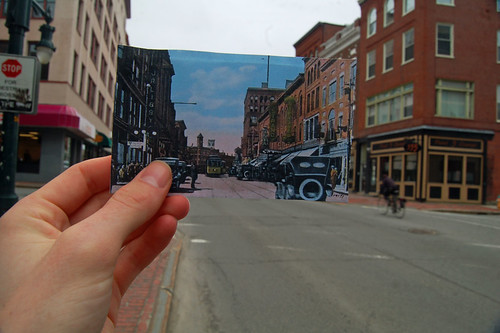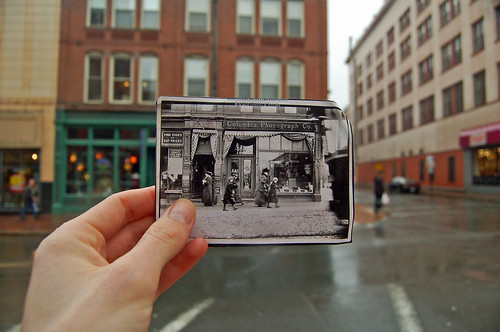
A few weeks ago I needed to pick up my newly-repaired camera at the FedEx warehouse out on Hutchins Drive, in Portland's industrial park fringe. So I hopped on my bike and rode to Stroudwater, where
Portland Trails maintains a lovely hiking path through the woods next to the Stroudwater River. Following is a photo-illustrated guide to the hike. Since I didn't have my camera until the return trip, these photos are shown in the opposite order in which they were taken.
As the map above shows, the trail begins just off of Congress Street in a subdivision called River's Edge Drive. A Portland Trails sign marks the trailhead. You go down a hill to the actual river's edge, and wind along there just out of sight of suburban backyards. One of the Rivers Edgers has ingeniously appropriated a city sewer vault as a canoe rack. Who cares if your canoe smells a bit like sewage? Especially if you're paddling the Stroudwater, which includes a couple of sewer overflow outlets and cow farms along its banks?

Since the trail follows the river, it takes substantially longer to follow its loopy course than it would to walk a parallel route along the road. But soon, the terrain gets hillier as the bank leading down to the river also becomes steeper and the trail diverges from the riverside. Unfortunately, my own hike was too long ago for me to remember many of the trees and forest types I was passing through, but I do recall a lot of hemlock trees in this stretch, in the damper, shaded soils along the riverbank's north-facing slopes.
Fairly suddenly, you'll break out of the darkish coniferous forest into an open deciduous forest carpeted by ferns, and not long after that you'll walk through this clearing:

This is the pipeline corridor of the
Portland Pipe Line Corporation, Quebec's primary oil lifeline, which connects tanker ships in Portland harbor to oil refineries near Montreal. So in theory, you could follow this path all the way to Montreal, but you'll have to cross a number of rivers along the way (like the one a few yards to your north here) without the benefit of bridges, and besides, as the signs here will tell you, trespassing in the pipeline corridor is not allowed.
Continuing west, then, you'll soon return to the riverbank by walking along boardwalks in the soggy floodplain. Across the river here is a pungent meadow, where the City of Portland's last resident cows chew their cud in sight of the Maine Turnpike.
The trail soon leaves the floodplain and climbs uphill again, until it reaches another clearing hemmed in by a spectacular wall.

Beyond this wall is an
eleven acre parking lot - one of several asphalt plains that surround the UNUM headquarters. On the trail's side of the wall is a small wetland filled with cattails and other grasses that help filter the parking lot's toxic doses of stormwater runoff. Also note the sumac in the left side of this photo - it's a sun-loving pioneer species that's frequently found at the edges of meadows and other disturbed areas in temperate deciduous forests.
You'll barely leave the great wall of parking behind when you arrive at another, louder clearing: the bridges where the Maine Turnpike carries four lanes of freeway traffic over the Stroudwater River.

But as soon as you put the Turnpike behind you, there's a time warp! It seems as though you've stumbled into the early nineteenth century... from every parked car, you expect to see emerging a barrel cooper, or a blacksmith, or a fugitive slave bounty hunter!

No, you're still in the year 2008. But here at the Sturbridge Yankee Workshop, history really seems to spring to life! Inside, skilled craftsmen are practicing a time-honored American tradition: distributing decorative accents and furniture that have been shipped from China.
The trail leaves the Workshop's parking lot and descends to a small parking area at the end of Blueberry Road, which leads back to Congress Street. Continuing along the trail, though, you'll enter the woods again, although a razor-wire fence soon appears in the woods to your left. Beyond emanates a steady industrial thrum:

This is ecomaine's waste-to-energy incinerator, which burns the majority of the Portland region's garbage and uses the heat to produce electricity. This is a place that deserves a blog post of its very own, and I plan to write it soon. As the trail passes opposite the incinerator's huge smokestack, you can find a mysterious PVC pipe emptying a steady drip of unknown liquid onto the trail (the pipe seems to lead straight towards the incinerator).
Past this point, the trail is closed in the winter, since the woods beyond the incinerator contain some of Portland's only winter habitat for white tailed deer. The trail winds through upland forests for another half mile or so and passes a minor power line corridor before reaching Hutchins Drive.

The last fifty yards or so of Hutchins (pictured) are barricaded from traffic and overgrown with ten to twenty years' worth of encroaching plant growth. It's kind of neat to see the forest overtaking the no parking signs and guardrails. Even in the middle of the street, weeds are beginning to take over from widening cracks in the pavement.
The trail continues a bit further on to the Westbrook town line, but this is where I turned around. If you're reading this on the blog, just scroll up and read this whole post backwards to get back to where you started.



















































